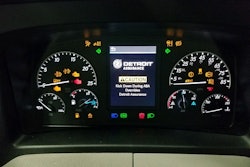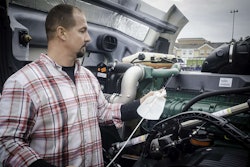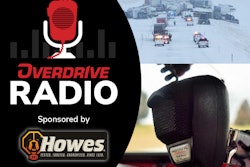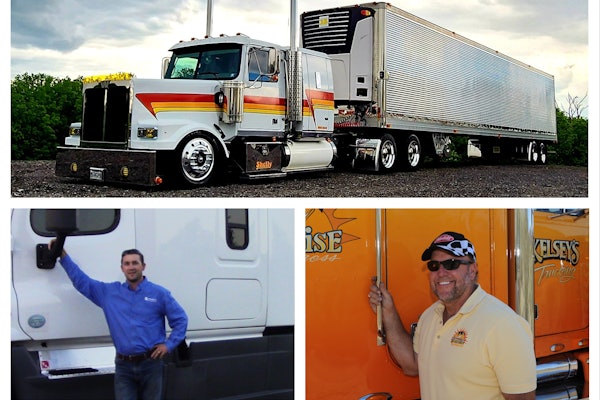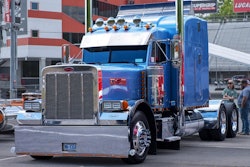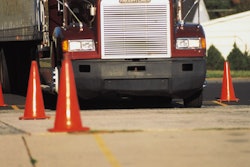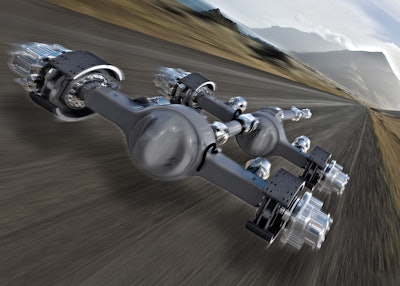 Downspeeding uses high-speed rear axles combined with high-torque lower-rpm engines. With this powertrain combination, the engine revs less at any given highway speed and receives a corresponding fuel economy boost.
Downspeeding uses high-speed rear axles combined with high-torque lower-rpm engines. With this powertrain combination, the engine revs less at any given highway speed and receives a corresponding fuel economy boost.The rapid industrywide adoption of the automated manual transmission has been accompanied by the related trend of downspeeding and lower axle ratios. The slower engine speeds have brought about significant savings in fuel costs and other efficiencies.
“Downspeeding is about reducing the amount of trips the piston takes up and down the engine, which reduces friction,” says John Moore, powertrain product marketing manager for Volvo Trucks North America. “This is actually where we’re saving the fuel.”
Volvo’s XE13 package that debuted in 2011 reduced rpm at cruise from about 1,370 to about 1,150. Newer iterations of downsped drivelines routinely cruise near 1,050 rpm.
Every reduction of 100 rpm is worth about 1.5 percent in reduced fuel consumption. So being able to maintain highway speeds at 1,150 rpm versus 1,370 constitutes a fuel savings of more than 3 percent.
A downsped driveline lets the engine operate at its most efficient rpm while also generating the minimal horsepower required to maintain a 65-mph cruise.
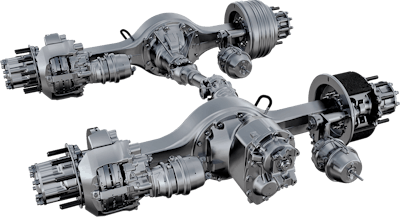 Meritor’s 14X HE rear axle targets linehaul customers seeking fuel efficiency and has superfast ratios down to 2.15 for aggressive downspeeding. It offers an 1,850 lb.-ft. torque rating and an 80,000-lb. GCW rating.
Meritor’s 14X HE rear axle targets linehaul customers seeking fuel efficiency and has superfast ratios down to 2.15 for aggressive downspeeding. It offers an 1,850 lb.-ft. torque rating and an 80,000-lb. GCW rating.“There is a combination of factors for the engine fuel efficiency improvements,” says Carlos Pinotti, Meritor’s senior director of rear drivetrain engineering. He cites reduced engine friction due to lower piston speed and reduced heat transfer and flow losses due to lower gas velocities and improved thermodynamic efficiency.

“The slower that engine is turning, you’re not running the water pumps, accessory drives and all those things nearly as fast, not to mention fewer cycles per minute,” says Mike Garrison, Eaton application engineer.
Reduced heat and friction also lead to less component wear, potentially extending engine life.
“An AMT is capable of making shifts at the appropriate time to keep the rpm low,” Garrison says. It takes into account real-time driving factors to optimize the shift strategy and balance performance with fuel economy.
Behind the AMT, a taller rear gear ratio lessens engine speed and improves fuel efficiency. Axle ratios have been getting faster with a lower numerical value, Garrison says.
“For overdrive transmissions, common axle ratios were in the mid and low 3s,” he says. “Today, with a lot of these linehaul downspeeding specs, it starts with a 2.”
Nearly 25 percent of the rear ends Meritor sold in 2011 came with a 3.55 axle ratio. By 2016, that share had dropped to about 5 percent.
Across 40,000-pound axle, linehaul and 6×4 applications, a 2.64 ratio has climbed from about a 7 percent order share to about 13 percent in that same timeframe. It’s now the leading ratio among Meritor products.
“The axle ratio’s range shiſted toward faster ratios due to downspeeding,” says Pinotti. “By the end of 2016, 2.64 and 2.47 ratios represented 25 percent-plus direct-drive and overdrive transmissions.”
A 2.47 ratio was the biggest gainer over those five years, climbing from less than 3 percent to a nearly 10 percent order share.
The engine’s output torque has improved, helping to further enable downspeeding by making torque available deeper in the rpm range, Garrison says. That could be an important factor in an owner’s next truck trade.
“Whatever ratios you were spec’ing on previous powertrains likely need to change anyway,” says Steve Slesinski, Dana’s director of global product planning for commercial vehicles. “Don’t just say, ‘I’ve always run a 3.55 ratio. I want that in my next truck.’ ”
Similar to an aerodynamic package, all the pieces of a downsped driveline have to be chosen carefully to work in unison.
Engine downspeeding means a reduced input shaft speed but requiring increased torque to deliver the same power, notes Pinotti. That places increased load demand on the driveshaſt at highway speed and startup.
As driveshaſt speed slows down at highway cruise speed, the amount of torque going through the driveshaft and axle system increases, Slesinski says.
Tom Bosler, Dana’s global driveshaſt product management leader, says fleets that failed to specify a driveshaft compatible with a downsped driveline have experienced premature U-joint failures. “If you take a truck that was running at 1,450 rpm down to about 1,125, that rpm change of 325 rpm results in a 36 percent change in driveshaft and rear axle life,” he says.
Variables in play with downspeeding include engine specification, type of transmission and rear axle ratios. However, much of the heavy lifting lies with the transmission.
The integrated driveline allows the system to calculate what Moore calls “perfect shiſt points” based on the truck’s load, road grade and required torque. Soſtware options are flexible for application-specific needs and to promote performance or fuel economy. “A variety of shiſter packages go along with that,” he says.
While the transmission’s soſtware is optimized for downspeeding, the unit itself is mostly a stock AMT.
“The transmission knows how to hold the gears as long as possible to get the best payback on the fuel efficiency,” Moore says. “We never could downspeed with a manual transmission, because a driver, every time he hit an overpass, would have to downshift to get over the overpass without losing too much speed. The driver would have to continually be shifting.”
[related-post id=”70807″/]Downspeeding pays off best in long-haul applications
Downspeeding is best suited for truckload over-the-road applications that spend a lot of time in top gear.
“A typical stop-and-go application isn’t going to benefit much more from having performance or capability,” says Meritor’s Carlos Pinotti. “You need startability much more than a cruising speed in a downsped range.”
Even if you run few on-highway miles or don’t spend long stretches in top gear, meaning you won’t reap downspeeding’s fuel economy benefits, there still are benefits to be had, says Dana’s Steve Slesinski.
“You’re running the engine less rpm over its lifetime,” he says. “Fewer revolutions over a period of time should in fact be better for the components.”
An engine running at a lower rpm also translates to a quieter cab in almost every application, says John Moore of Volvo Trucks North America.
Specifying a downsped setup also can be a tricky proposition for a truck used in varied driving terrain. In that situation, it’s often best to have a more general specification capable of running a mixture of highway, rural and urban routes.
Eaton’s Mike Garrison says another challenge is driving speed. While the trend in downspeeding is to look at cruise rpm, the operating road speed can vary significantly from state to state, making it tough to optimize specifications when drivers frequently cross regions.
“People really need to understand what speeds they are going to run and how are they going to handle these slower states,” he says. “That really can make a difference in them realizing the kinds of benefits they are looking for.”



